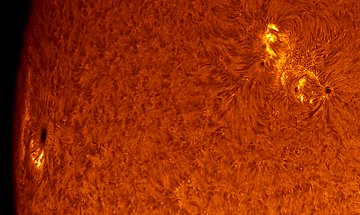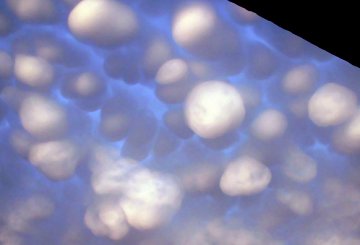 The space shuttle will fly over the United States in July. Would you like to see it? Sign up for Spaceweather PHONE.
The space shuttle will fly over the United States in July. Would you like to see it? Sign up for Spaceweather PHONE.
CRESCENT MOON: When the sun goes down tonight, a thin crescent Moon will materialize in the western sky--nothing special, just very pretty. Don't miss it: sky map.
NEW SUNSPOTS: "Two stunningly beautiful sunspots have exploded into view," says amateur astronomer Greg Piepol who photographed the active regions earlier today:

Sunspot 897, in particular, is growing with wild abandon, changing visibly as onlookers watch. Unstable magnetic fields could snap, resulting in solar flares, although so far no explosions have been observed.
more images: from Pete Lawrence of Selsey, West Sussex, UK; from Andreas Murner of Lake Chiemsee, Bavaria, Germany.
MAMMATUS CLOUDS: Monday in the Czech Republic, Matus Kocka photographed some "very strange clouds" hanging over Brno where he is going to college:

These are mammatus clouds. They form in turbulent air on the undersides of thunderstorms. Although mammatus clouds are popularly thought to signal the approach of severe weather, new research shows the opposite is true. These lumpy clouds are most often seen when storms are breaking up. Indeed, Kocka took his pictures "after some strong weather" swept through Brno.
Unsolicited advice: the next time you step outside after a storm, look up and around for mammatus clouds.
more images: from Rudolf Novak of Brno, Czech Republic; from Jorn Olsen in Hastings, Nebraska.

